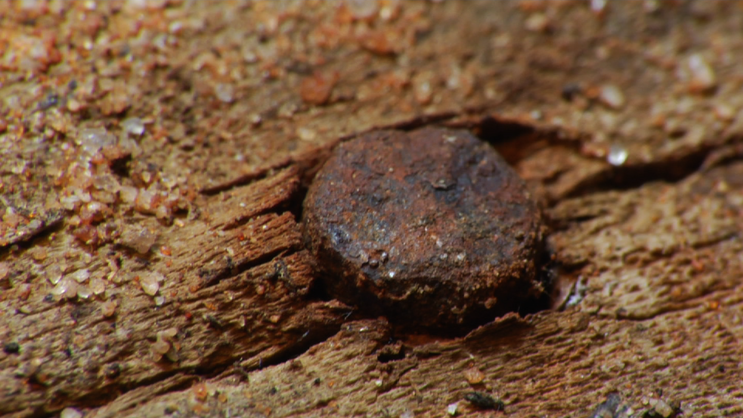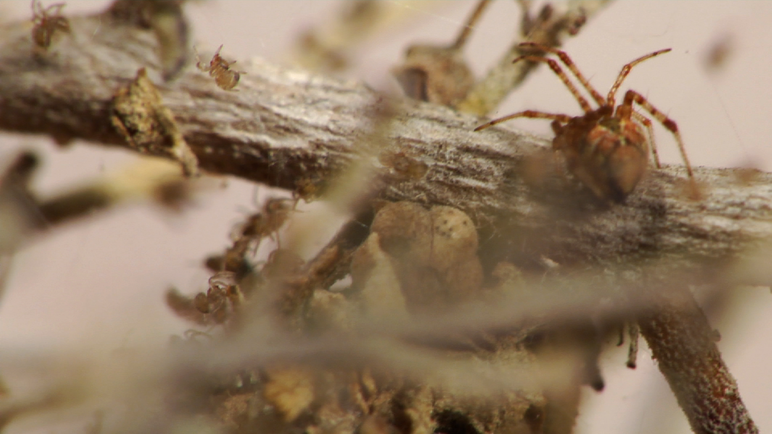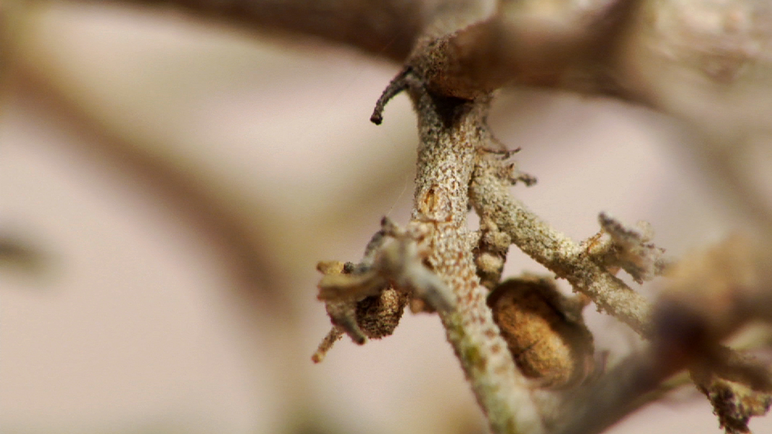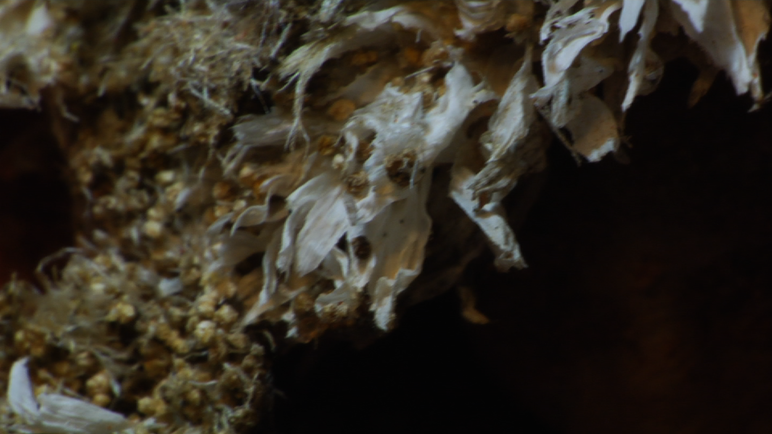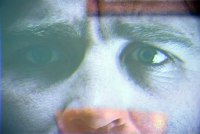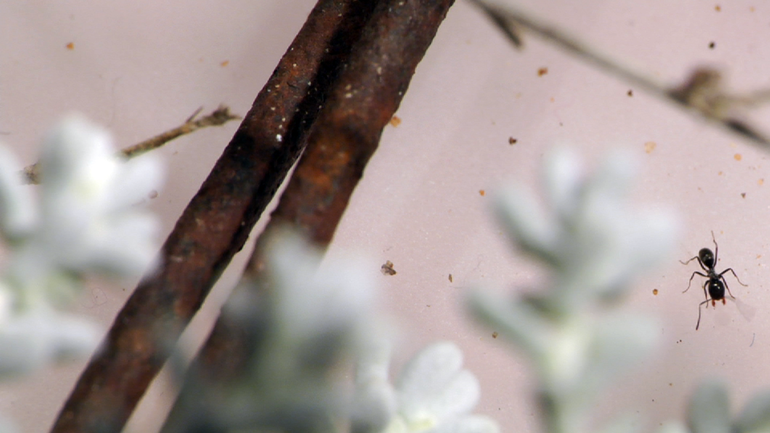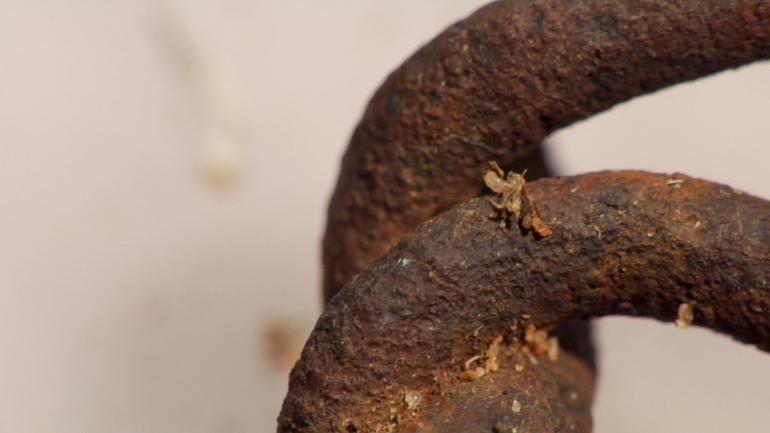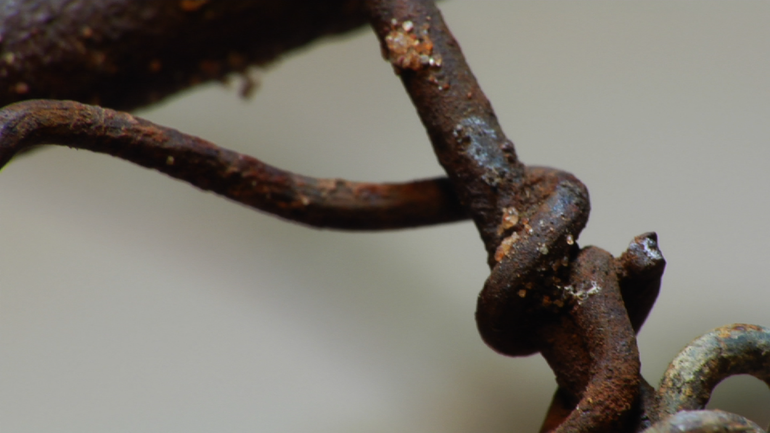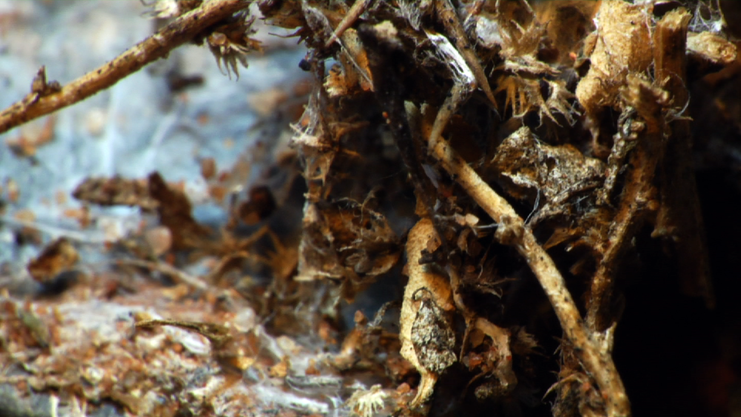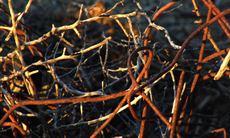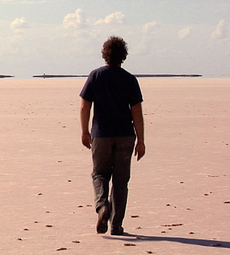Zanci Station: exploded diagram was a two-screen installation, which was exhibited as part of the Tract exhibition I curated at Margaret Lawrence Gallery in Melbourne. My work was created from artefacts that were found on the site of Zanci Station in the Lake Mungo National Park in south-western New South Wales.
In Zanci Station: exploded diagram, my figure disappeared entirely to be replaced by more of the minute details of an environment, which accumulated over the length of the installation to point towards the multiple narratives of place that intersect at that site. Lake Mungo National Park is a site of significance across cultures and millennia; it is the place in which the remains of Mungo man and Mungo woman were found, two sets of remains which have been dated to forty thousand years and which provide the earliest evidence of cremation. It was later colonised and turned over to sheep grazing before finally being recognised as a site of national and international significance and falling under the protection of the National Parks service.
I have made a number of works in places that are in between different areas of land use, places where detritus accumulates but becomes invisible because no one is directly responsible for it. I have made work about collections of rubbish on boundaries that are far flung: two reindeer herding co-operatives in the north of Finland; the sides of roads across inland Australia; between an old village and a new freeway in Shanghai; and culverts and drains between towns and rivers. Zanci Station: exploded diagram took this work in a new direction by reading the archaeology of an old farm in a national park and finding evidence of indigenous species, introduced species, remnants of precolonial aboriginal culture, and the remains of the station itself in the form of wood and metal artefacts, as well as evidence of its postcolonial status as a National Park. Picking up on Kwon’s observation and its attendant challenge as outlined in the previous section on WIRE, the rhetoric and reality of global ‘non-spaces’ in our present moment has brought challenges that warrant a recalibration of our experience of time and space to recognise and re-particularise the local. Zanci Station: exploded diagram returns to the source; it exclusively images the undeniably physical details of place as a means to ‘re-position’ us. This work found different means of locating narratives in sites than those employed in WIRE. The protagonist searching the ground has been entirely overtaken as the scale and detail of the search increased to bring us that much closer – indeed through a series of macro lenses we are 7.8 times closer to the subject.
I used a number of devices within this artwork to evoke scientific imaging and ‘study’ as a means of representing the relationship between the ‘rational’ analysis of science and industry and the ‘subjective’ views of artistic practice. There is the previously mentioned use of stronger and stronger lenses such that the details imaged are on the border of visibility to the naked eye, a strategy that evokes the unseen and impossible perspectives of botany and biology. In the particular case of Zanci Station: exploded diagram, I also used the archaeological convention of gridding-up the site and then creating a close scan of points along the grid. As can be seen in the installation documentation, this was further played out in one of the projections, which echoed this grid form. I felt that by imaging the undeniably physical details of a place, I could if not reconcile then at least express contemporary conventions that oppose science and art. These devices were intended to evoke natural history illustration and serve as problematic ‘markers’ of objectivity.
I have almost stopped editing in what I have come to call my ‘traces’, these meandering searches through these micro-environments. Zanci Station: exploded diagram uses the roving, questing movement camera I described in the essay on WIRE, though here there is less bodily movement evident in the ‘eye’ of the camera. Through its micro-perspective, the camera searches the remnants of plant, wood, metal, and stone for the truth of the environment but ultimately distorts and aestheticises, providing no truth at all. In an attempt to re-particularise an environment, it curiously provides us with both more information and less at the same time. With its minuscule detail it allegorises our fleeting and subjective engagement with place, creating a visual poetry of detritus. The extended choreographed shots search to find different means to render time: the temporary, the fleeting, the dynamic and fluxing. In doing so, they acknowledge our incapacity to ‘fix’ the landscape and thereby embody the truth of our transitory moment, our fleeting glance.
As I have been drawn closer and closer to the peculiarities of particular sites, and am thus less and less in the picture myself, it would make sense to assume that the work trades on greater objectivity. Paradoxically, the images I produce in this way continue to reflect, or resonate with, my psychology. I don’t think they depict or represent it in any legible way but they feel to me more deeply connected to an internal imaging than the far more overt and externalised naval gazing of my earlier performative practice.
Over the course of the seven years since I began making work in the Mallee, I have increasingly pondered what it is that finds me ‘reflected’ in the landscape in this way. People have articulated a longing for that deep sense of recognition since the advent of landscape as a genre, when painters and the first tourists went in search of the sublime view. But the idea that we have lost contact with something essential, something that we glimpse in the landscape and that needs to be found and with which we need to reconnect, is not new. The exile from the garden seems to be an enduring rift, felt at a deep level both intellectually and emotionally. Tacita Dean and Jeremy Millar brought home just how enduring when I encountered the following quotation at the start of Place,
The question, what is place? presents many difficulties. An examination of all the relevant facts
seems to lead to different conclusions. Moreover, we have inherited nothing from previous thinkers,
whether in the way of a statement of difficulties or of a solution. (Aristotle 1:355, Physics 4.1, 208a32–208b1)
Perhaps the persistent nature of this ‘problem’ of place requires each generation, individual, and moment to bring to bear necessarily new tools to reframe the question in a manner that is meaningful to them. But while my approach to landscape can be described as contemporary by virtue of the technology I use and the ultimately anti-pictorial quality of the work, I am nevertheless engaging with a problem as old as us: what is this place?
The sentimentality and quasi-spirituality of the search for the sublime has been eclipsed in public discourse by the often-reductive rationality that infects contemporary life. But the searching, the deep looking, and the listening remain.
I only went out for a walk and finally concluded to stay out
till sundown, for going out, I found, was really going in.
(John Muir 311)
As Muir suggests, we seek something more than a measure of phenomena, a simple witnessing. It is not only me for whom there is something of the self-reflected in our experience of landscape. But the ineffable and elusive quality of the subject of that search is made evident because as I write I cannot find a satisfactory word to capture these places. ‘Nature’ is the right word, etymologically speaking, for amongst its Latin roots, ‘natura’ is, for one, the study of physical things, things in the world. In contemporary theory, however, nature has slipped away to become considered, perhaps rightly enough, as another product of culture, whether it be agricultural land, land reclaimed for state or national parks, or those all too rare wilderness spaces left largely untouched by settler Australians. Academically this is now a form of received knowledge, established by scholars such as Doreen Massey or Thomas Greider and Lorraine Garkovich:
'Landscapes' are the symbolic environments created by human acts of conferring meaning onto nature and the environment, of giving the environment definition and form from a particular angle of vision and through a special filter of values and beliefs. Every landscape is a symbolic environment. These landscapes reflect our self-definitions that are grounded in culture. (Greider and Garkovitch 1)
In introducing their notion I feel some regret, for while I find their argument compelling, I also find it problematic. My ‘problem’ with landscape being understood as a cultural construct is not with its logic, which rings true for me, but rather that it renders the environment as an intellectual matrix. For I am most interested not in looking at textual abstractions of the environment but in engaging with the physicality of environment itself.
I have attempted to reconcile these two contradictions within my work. Or rather, my work provides a place for my own negotiation of these two contradictory but equally valid viewpoints; a space in which I am present both physically and symbolically. Imaging is representing surely, but since the approach to painting pioneered by J. M. W. Turner, abstraction in landscape has provided a means to link perception, inner states, and the physical environment. From protomodernists such as Turner, through impressionism and the seminal seascapes of Mondrian, landscape was a foundational element of the modernist abstraction project. But whilst abstraction is often misunderstood as a means of confusing that which is being depicted, many artists use it as a means of seeing more clearly, as I feel is the case when I look at the work of artists such as those mentioned in this exposition. Imaging is a record of seeing, and when one sees deeply, one inhabits. The hand-eye relationship that sits inside imaging practices requires an attendance to what one is really seeing, and to do it one must get past the semiotic shorthand that we use to navigate the world and which makes us see – necessarily – only plant, sun, road, dog. This can lead to highly detailed and naturalistic renderings of visual phenomena but it may also lead to results that are not immediately recognisable as such.
Zanci Station: exploded diagram
Year: 2011
2 screen installation
with surround sound by Philip Samartzis
As I have described, I set out to develop a set of practices that could critique the pictorial, and arguably reductive, tradition of the camera, the tool most associated with the ‘true-to-appearances’ tradition of naturalism. I needed to find a way for the camera no longer to sit between my environment and myself but to act as an aid in inhabiting it, within the limits and demands of my own practice in video. As mentioned above, part of this navigation has been to embed the notion of a transitional or ‘between’ state into my subject matter, making video works in places that lie physically between different areas of land use, or are in temporal transition from one state to another. These works, like Zanci Station: exploded diagram, read the archaeology of rubbish between differently designated zones of activity. The liminal zones that are the subject of these works provide a visual analogue of place as a contested latticework of intersecting narratives of ownership, usage, creation, and fiction. I find these environments dense with possibility and my engagement with them has subsequently been filled out through encountering Heidegger’s interpretation of the Greek ‘poiesis’ (10). My video navigations of contemporary middens do not perhaps present Heidegger’s ‘bringing forth’ in its most alluring guise, but it does seem to me nonetheless a form of becoming and ‘unconcealment’ (ibid.). I recognise this in the ‘organic’ and viral spread of the human species that is expressed in the cities, settlements, and infrastructure for which these boundaries and bleeding edges form the threshold, the zone where one thing consumes and becomes another. But also I see it in my use of my craft to bring into ‘unconcealment’ that which is previously concealed. I don’t claim any revelatory role in this but simply lay claim to the general truth of many artistic practices which are predicated upon a re-seeing, a seeing anew for themselves and, through the act of representation, for others.
